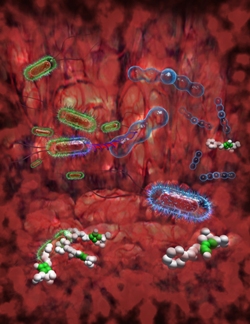 Sciencemag | Humans have been doing battle with bacteria since the 1800s, thwarting disease with antibiotics, vaccines, and good hygiene with mixed success. But in 2000, Nobel laureate Joshua Lederberg called for an end to the “We good; they evil” thinking that has fueled our war against microbes. “We should think of each host and its parasites as a superorganism with the respective genomes yoked into a chimera of sorts,” he wrote in Science in 2000.
Sciencemag | Humans have been doing battle with bacteria since the 1800s, thwarting disease with antibiotics, vaccines, and good hygiene with mixed success. But in 2000, Nobel laureate Joshua Lederberg called for an end to the “We good; they evil” thinking that has fueled our war against microbes. “We should think of each host and its parasites as a superorganism with the respective genomes yoked into a chimera of sorts,” he wrote in Science in 2000.His comments were prescient. This past decade has seen a shift in how we see the microbes and viruses in and on our bodies. There is increasing acceptance that they are us, and for good reason. Nine in 10 of the cells in the body are microbial. In the gut alone, as many as 1000 species bring to the body 100 times as many genes as our own DNA carries. A few microbes make us sick, but most are commensal and just call the human body home. Collectively, they are known as the human microbiome. Likewise, some viruses take up residence in the body, creating a virome whose influence on health and disease is just beginning to be studied.
Their genes and ours make up a metagenome that keeps the body functioning. This past decade we've begun to see how microbial genes affect how much energy we absorb from our foods and how microbes and viruses help to prime the immune system. Viewing the human and its microbial and viral components as intimately intertwined has broad implications. As one immunologist put it, such a shift “is not dissimilar philosophically from the recognition that the Earth is not the center of the solar system.”
This appreciation has dawned gradually, as part of a growing recognition of the key role microbes play in the world. Microbiologists sequencing DNA from soil, seawater, and other environments have discovered vast numbers of previously undetected species. Other genomics research has brought to light incredible intimacies between microbes and their hosts—such as a bacterium called Buchnera and the aphids inside which it lives. A study in 2000 found that each organism has what the other lacks, creating a metabolic interdependency.
One of the first inklings that microbiologists were missing out on the body's microbial world came in 1999, when David Relman of Stanford University in Palo Alto, California, and colleagues found that previous studies of bacteria cultured from human gums had seriously undercounted the diversity there. Turning to samples taken from the gut and from stools, the researchers identified 395 types of bacteria, two-thirds of them new to science.
In 2006, Steven Gill of the University at Buffalo in New York and colleagues did a metagenomics study of the gut, analyzing all the genes they could find in the 78 million bases sequenced. They found metabolic genes that complemented the human genome, including ones that break down dietary fiber, amino acids, or drugs, and others that produce methane or vitamins. This and a more comprehensive survey in 2010 by Jun Wang of BGI-Shenzhen in China and colleagues provided support for the concept of the microbe-human superorganism, with a vast genetic repertoire. Now, large-scale studies have surveyed the microflora in the gut, skin, mouth, nose, and female urogenital tract. The Human Microbiome Project has sequenced 500 relevant microbial genomes out of a planned 3000.
Some of these microbes may play important roles in metabolic processes. In 2004, a team led by Jeffrey Gordon of Washington University School of Medicine in St. Louis, Missouri, found that germ-free mice gained weight after they were supplied with gut bacteria—evidence that these bacteria helped the body harvest more energy from digested foods. Later studies showed that both obese mice and obese people harbored fewer Bacteroidetes bacteria than their normal-weight counterparts.
The microbiome is also proving critical in many aspects of health. The immune system needs it to develop properly. What's more, to protect themselves inside the body, commensal bacteria can interact with immune cell receptors or even induce the production of certain immune system cells. One abundant gut bacterium, Faecalibacterium prausnitzii, proved to have anti-inflammatory properties, and its abundance seems to help protect against the recurrence of Crohn's disease. Likewise, Sarkis Mazmanian of the California Institute of Technology in Pasadena showed that the human symbiont Bacteroides fragilis kept mice from getting colitis. And inserting bacteria isolated from healthy guts restored the microbial communities, curing chronic diarrhea in a patient infected with Clostridium difficile.
Herbert Virgin of Washington University School of Medicine finds a similar role for the virome. In mice, his team found that dormant herpesviruses revved up the immune system just enough to make the mice less susceptible to certain bacterial infections.
The ideas of a microbiome and a virome didn't even exist a decade ago. But now researchers have reason to hope they may one day manipulate the body's viral and microbial inhabitants to improve health and fight sickness.








